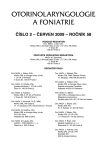-
Medical journals
- Career
Parapharyngeal and Retropharyngeal Abscess in Children
Authors: P. Dytrych 1; Z. Kabelka 1; R. Katra 1; M. Marková 1; M. Kynčl 2; M. Jurovčík 1
Authors‘ workplace: Klinika ušní, nosní, krční 2. LF UK a FN Motol, Praha Subkatedra dětské otorinolaryngologie IPVZ, Praha ; přednosta doc. MUDr. Z. Kabelka Klinika zobrazovacích metod 2. LF UK a FN Motol, Praha 1; přednosta doc. MUDr. M. Roček, CSc. 2
Published in: Otorinolaryngol Foniatr, 58, 2009, No. 2, pp. 79-82.
Category: Original Article
Overview
Parapharyngeal (PPA) and retropharyngeal abscess (RPA) are relatively rare, but serious deep throat infections, associated with potentially significant morbidity and mortality. In spite of the primary tendency to evacuate the area of the abscess the possibility of conservative approach in the treatment is still under professional consideration. In the three-year period of 2005 through 2007 the authors treated 13 child patients with this kind of diagnosis. The suspicion based on clinical picture was confirmed by imaging of the inflammatory focus by magnetic or CT with the use of a contrast medium. Four children with a lesion of a smaller size and abscess positioned high under the cranium base were successfully treated conservatively only. In 9 patients a surgical intervention was indicated. Six of them were treated by means of transoral incision and evacuation of the abscess. In three patients the transoral puncture proved to be negative (without aspirated purulence). Among these three patients two were cured up conservatively without the need of further intervention, in the third patient with multiple abscesses in parapharyngeal, retropharyngeal and paravertebral region, revision from external approach was performed. The intraoral incision of the same focus had to be performed twice in two patients. All these patients finally healed up completely. In six patients who were cured up without surgical evacuation of the abscess the foci proved to be of smaller size and less apparent clinical symptomatology. No postoperative complications have been encountered, and all patients of the group survive.
Key words:
parapharyngeal abscess, retropharyngeal abscess.
Sources
1. Al-Sabah, B., Bin Salleen, H., Hagr, A., Choi-Rosen, J., Manoukian, J. J.,,Tewfik, T. L.: Retropharyngeal abscess in children: 10 year study. Otolaryngol., 33, 2004, s. 352-355.
2. Berger, T. J..: Retropharyngeal abscess. 2006-03-28. Dostupný z www: http://www.emedicine.com/ped/topic2682.htm.
3. Boucher, C., Dorion, D., Fisch, C.: Retropharyngeal abscess. A clinical and radiologic correlation. Otolaryngol, 28, 1999, s. 134-137.
4. Choi, S. S., Vezina, L. G.,Grundfast, K. M.: Relative incidence and alternative approaches for surgical drainage of different types of deep neck abscesses in children, Arch. Otolaryngol Head Neck Surg., 12, 1997, s. 1271-1275.
5. Craig, F.W., Schunk, J.E.: Retropharyngeal abscess in children: clinical presentation, utility of imaging, and current management. Pediatrics, 6, 2003, s. 1394-1398.
6. Daya, H, Lo, S., Papsin, B. C., Zachariasova, A., Murray, H., Pirie, J., Laughlin, S., Blaser, S.: Retropharyngeal and parapharyngeal infections in children: the Toronto experience. Int. J. Pediatr. Otorhinolaryngol, 1, 2005, s. 81-86.
7. Hawkins, D. B., Austin J. R.: Abscesses of the neck in infants and young children. A review of 112 cases. Ann. Otol. Rhinol. Laryngol., 5, 1991, s. 361-365.
8. Hobbs, C. G. L., Pinder, D. K.: Parapharyngeal abscess: a diagnosis not to miss. Hospital Medicine, 2, 2003, s. 114-118.
9. Jeong - Hoon, O., Youngju, K., Chul Ho, K.: Parapharyngeal abscess: Comprehensive Management Protocol. ORL, 69, 2007, s. 37-42.
10. Komínek, P., Chrobok, V., Astl, J. a kolektiv: Záněty hltanu, Tobiáš, 2006, s. 245-250.
11. McClay, J. E., Murray, A. D., Booth, T.: Intravenous antibiotic therapy for deep neck abscesses defined by computed tomography. Arch. Otolaryngol. Head Neck Surg,, 11, 2003, s. 1207-1212.
12. Page, C., Biet, A., Zaatar, R., Strunski, V.: Parapharyngeal abscess: diagnosis and treatment. Eur Arch. Otorhinolaryngol., 265, 2008, s. 681-686.
13. Sichel, J. Y., Gomori, J. M., Saah, D., Elidan, J.: Parapharyngeal abscess in children: the role of CT for diagnosis and treatment. Int. J. Pediatr. Otorhinolaryngol., 5, 1996, s. 213-222.
14. Stárek, I. a kol.: Nádory parapharyngu, diagnostika a léčba. 1. vyd. Havlíčkův Brod, Tobiáš, 2006, s. 24.
15. Stone, M. E., Walner, D. L., Koch, B. L., Egelhoff, J. C., Myer, C. M.: Correlation between computed tomography and surgical findings in retropharyngeal inflammatory processes in children. Int. J. Pediatr. Otorhinolaryngol., 5, 1999, s. 121-125.
16. Vural, C., Gungor, A., Comerci, S.: Accuracy of computerized tomography in deep neck infections in the pediatric population. Am. J. Otolaryngol., 24, 2003, s. 143-148.
17. Zahraa, J. N., Al-Boukai, A. A.: Acute retropharyngeal abscesses in children. Saudi Med., 8, 2002, s. 899-903.
18. Zeleník, K., Komínek, P., Matoušek, P., Hladík, M.: Retrofaryngeální absces. Pediatr. pro praxi, 8, 2007, s. 389-390.
Labels
Audiology Paediatric ENT ENT (Otorhinolaryngology)
Article was published inOtorhinolaryngology and Phoniatrics

2009 Issue 2-
All articles in this issue
- Foreign Bodies in ORL Area in Children
- Parapharyngeal and Retropharyngeal Abscess in Children
- Radiofrequency Induced Tonsil Thermotherapy in Children
- Prognostic and Predictive Significance of Expression of EGFR, Her2/neu and Genetic Alterations in EGFR Signaling Pathway in Spinocellular Carcinoma of Head and Neck
- Oropharyngeal Presence of Helicobacter Pylori and Its Relation to Stomach Infection
- Incidence of Helicobacter Pylori in Nasal Lymphatic Tissues and its Possible Link to Adenoidal Vegetation
- Primary (spindle cell) Rhabdomyosarcoma of Submandibular Salivary Gland
- Cholesteatoma in Occipital-temporal Region
- Peripheral Facial Nerve Palsy on Otologic Manifestation of Wegeneręs Granulomatosis
- Otorhinolaryngology and Phoniatrics
- Journal archive
- Current issue
- Online only
- About the journal
Most read in this issue- Parapharyngeal and Retropharyngeal Abscess in Children
- Foreign Bodies in ORL Area in Children
- Radiofrequency Induced Tonsil Thermotherapy in Children
- Incidence of Helicobacter Pylori in Nasal Lymphatic Tissues and its Possible Link to Adenoidal Vegetation
Login#ADS_BOTTOM_SCRIPTS#Forgotten passwordEnter the email address that you registered with. We will send you instructions on how to set a new password.
- Career

